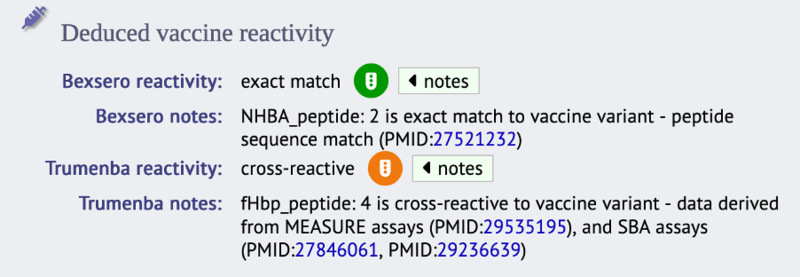The MenDeVAR Index
Genomic data is used by scientists and doctors around the world to respond to the threat of infectious diseases. In this series of blog posts, we’ll highlight research carried out by our group that uses genomic data to study disease-causing bacteria. The discoveries you are making through the Genome Detectives project will help us carry out more studies like these in the future!

This post discusses research carried out by our lab into the use of different vaccines against the bacterial species Neisseria meningitidis, which causes bacterial meningitis. You can read the full scientific paper, “Meningococcal Deduced Vaccine Antigen Reactivity (MenDeVAR) Index: A Rapid and Accessible Tool That Exploits Genomic Data in Public Health and Clinical Microbiology Applications” (Rodrigues, et al., 2020), here.
Group B Meningococcus
Bacterial meningitis is a serious infection of the protective membranes surrounding the brain and spinal cord. It can be caused by several species of bacteria including Neisseria meningitidis (the meningococcus). Meningococcal infections are generally sporadic – they occur infrequently as isolated cases – however outbreaks can occur where lots of people are living or working alongside one another, such as schools, universities, or military barracks.
The meningococcus can be divided into subtypes, known as serogroups, the most common of which is Group B (often referred to as MenB). Group B is currently the main cause of severe meningococcal disease outbreaks in Europe and North America1.
Vaccinating against MenB
Since 2014/15, two vaccines have been used to protect against disease caused by MenB:
- Trumenba® – manufactured by Pfizer
- Bexsero® (sometimes called 4CMenB) – manufactured by GlaxoSmithKline
The Trumenba and Bexsero vaccines both contain proteins found on the surface of MenB bacteria. They work by ‘training’ the immune system to recognise these proteins, so that if a MenB cell invades it can be quickly identified and destroyed.
The vaccine proteins can be:
- An exact match – the sequence of the protein in the vaccine is exactly the same as the sequence of the protein on the surface of the MenB cell
- Cross-reactive – the vaccine protein sequence is slightly different to the MenB cell surface protein sequence, but similar enough that the cell will still be recognised by the immune system following vaccination
The two vaccines contain a slightly different collection of proteins, meaning one may be more effective than the other against a given variant of MenB.
When outbreaks of meningococcal disease occur in a community, the spread of disease can be minimised by rapidly vaccinating those at risk. To make decisions about which vaccine to use, information is needed about:
- The sequence of surface proteins present on the MenB variant causing the outbreak
- Which vaccine will best train the immune system to recognise these proteins
This information can be worked out using laboratory techniques, but lab methods are often too slow to use in real-time clinical settings. This is where genomics comes in!
If tested in the lab, it takes several days to work out whether each vaccine is an exact match, cross-reactive, or ineffective against a MenB strain, due to the time it takes for bacterial samples to grow in test tubes. If this information is instead predicted from genomic data, results can be obtained within minutes.
The MenDeVAR Index
The MenDeVAR (Meningococcal Deduced Vaccine Antigen Reactivity) Index is a tool that uses genomic data to determine which vaccine to use against a given MenB variant2. It was created by Rodrigues and colleagues in 2020 and is available to use as part of the PubMLST database. PubMLST is an online database of bacterial genomes, associated data such as where the genomes were collected, and analysis tools including MenDeVAR.
The MenDeVAR tool predicts which vaccine, Trumenba or Bexsero, will work best against an outbreak of meningococcal disease based on genomic data obtained from the outbreak MenB variant.
The tool works as follows:
- A sample of bacteria is collected from the patient with meningococcal disease, and the bacterial genome (the DNA) is sequenced
- The genome sequence from the MenB variant is uploaded to PubMLST
- The amino acid sequences of the surface proteins coded for by the DNA are determined
- These protein sequences are compared to the sequences of the proteins that each vaccine contains
- The tool works out if the MenB and vaccine sequences:
- Are an exact match
- Are cross-reactive (using experimental evidence that has been published in scientific papers)
- Will not be cross-reactive (i.e., the vaccine will not work)
- Or determines if there is not enough data to make a prediction
- The outputs are displayed using a ‘traffic light’ system so it is easy to see the prediction for each vaccine
An exact match is best, because this means the immune system will be trained by the vaccine using exactly the same protein as is found on the outbreak MenB variant. A result of cross-reactive also means the immune system would be trained to produce a successful response if this vaccine was used. However, the response may be less efficient than if an ‘exact match’ vaccine was used. This is because being cross-reactive means the vaccine protein is slightly different to the MenB protein, instead of matching it exactly.
If an exact match is found, the exact match vaccine will be recommended for use during an outbreak. If an exact match is found for both vaccines, then both will be recommended. Where there is no exact match but one of the vaccines is found to be cross-reactive, then this vaccine is recommended. If both vaccines are cross-reactive, then both are likely to be effective and both will be recommended.

This image shows the MenDeVAR Index results for the Neisseria meningitidis variant ‘M21 240025’ on the PubMLST website. You can see that this MenB variant has an exact protein sequence match to the Bexsero vaccine (‘green traffic light’) and is also cross-reactive to the Trumenba vaccine (‘amber traffic light’). In this case, the Bexsero vaccine would be recommended because having an exact match is better than being cross-reactive.
This isolate is part of the Meningitis Research Foundation Meningococcus Genome Library, which was developed by Public Health England, the Wellcome Trust Sanger Institute, and the University of Oxford, and funded by the Meningitis Research Foundation. You can explore the other data known about this isolate on PubMLST, here.
Use of the MenDeVAR Index: a case study
In 2016, an outbreak of Group B meningococcal disease occurred at a university in New Jersey, USA3. MenB bacteria were isolated from the cerebrospinal fluid of patients and the genome sequences of these bacteria were determined by the local public health department. The MenDeVAR Index has retrospectively been applied to this outbreak and suggests that the outbreak MenB variant was cross-reactive with Trumenba but not cross-reactive with Bexsero2. This information could have been used to administer Trumenba to those at risk early on in the outbreak, which would have prevented further transmission of MenB.
Summary
By providing rapid real-time predictions of vaccine success, the MenDeVAR Index has the potential to play a key role in clinical policy making and public health intervention strategies.
If you are keen to discover more about MenDeVAR, you can read the paper by Rodrigues et al., here.
Images (in order): Mufid Majnun via Unsplash, 2021; PubMLST, 2023.


